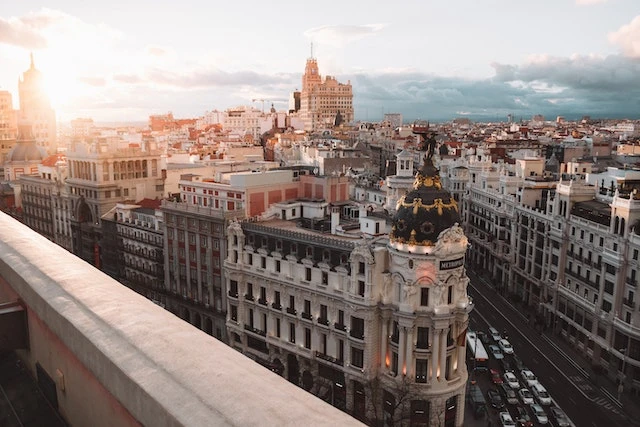
Moving Abroad

Container Shipping

Information & Popular Routes
Services

Find a Mover


¡Hola, future Madrileños! If you’re reading this, chances are you’re about to embark on an exciting new chapter of your life in Madrid. Or maybe you’re just daydreaming about the possibility. Either way, welcome! We are here to be your unofficial guide through the winding streets of Spain’s sun-drenched capital.
Now, we won’t sugarcoat it – relocating to a new city, especially one as bustling and vibrant as Madrid, can feel a bit like being a bull in a china shop at times. There’s the language barrier, the hunt for the perfect churro, and the desperate attempts to understand why everyone disappears for a couple of hours in the afternoon (Hint: It’s called ‘siesta’). But don’t worry, that’s where we come in.
In this blog post, we’re going to explore everything from finding your dream Spanish casa to making sense of the metro map. So grab a cup of café con leche, get comfy, and let’s dive into the beautiful chaos that is settling into Madrid. ¡Vamos!
First things first, why Madrid? Well, for starters, imagine living in a city where history and modernity dance together in a vibrant flamenco. That’s Madrid for you. It’s a city that wears its rich history with pride, from the grandeur of the Royal Palace to the timeless masterpieces in the Prado Museum. Yet, it’s also a city that’s constantly evolving. You’ll find cutting-edge design studios nestled in centuries-old buildings, trendy fusion restaurants tucked away in traditional markets, and an arts scene that’s as diverse as it is dynamic.
But Madrid isn’t just about the big attractions. It’s also about those little moments that make life worth living. The aroma of fresh churros y chocolate wafting through the air on a crisp morning, the feel of cobblestones under your feet in the Barrio de las Letras, the sight of locals and expats alike sharing laughter over tapas at a neighborhood bar. In Madrid, every day is a fiesta waiting to happen. And the best part? As a Madrileño, you’re invited to join in the fun. So why choose Madrid? The real question is, why not?
When we think of relocating to Madrid, one of the first things that might make us pause is the language. ‘Do we really need to know Spanish?’ is a common question. Let’s tackle this head-on. While it’s true that many expats live in Spain with minimal Spanish skills, knowing the language definitely enriches the experience. From striking up conversations with our friendly vecinos (neighbors) to understanding the menu del día at a local café, speaking some Spanish allows us to engage more deeply with the culture.
Now, don’t let this intimidate you. Young Spaniards generally have a good understanding of English, so you won’t be left stranded in a sea of incomprehensible chatter. Plus, Madrid is a cosmopolitan city with a large international community, so it’s possible to get by using English. But trust us, nothing beats the satisfaction of successfully ordering your first cafecito in fluent Spanish!
So how do we cope with the language barrier? Well, there are plenty of language learning apps and local language schools that offer Spanish classes for all levels. And let’s not forget about language exchange events – they’re fun, social, and a great way to learn Spanish while making new friends. So, while it’s not essential to be fluent in Spanish before you arrive, a little effort can go a long way in helping you feel part of the madrileño vibe.
Here’s a list of some popular neighborhoods in Madrid, each with their own unique charm:
Each of these neighborhoods has its own flavor, so it really comes down to what we’re looking for in our Madrid living experience.
When it comes to finding our nest in Madrid, there are plenty of options available. But before we start our hunt, it’s important to decide whether we want a furnished or unfurnished place.
For those of us who prefer to skip all the fuss associated with buying furniture and arranging for basic amenities, furnished apartments are a great choice. This is where Homelike comes in handy. With a wide range of fully furnished apartments in Madrid, it’s a favorite among many expats, even for long-term stays. The convenience of moving into a ready-made home can’t be overstated, especially when we’re still getting our bearings in a new city.
On the other hand, if we’re keen on personalizing our space and don’t mind setting things up from scratch, we might consider unfurnished rentals. Idealista is a popular platform that offers an extensive list of unfurnished properties across Madrid.
Whether we choose a chic studio in Salamanca or a spacious loft in La Latina, the key is to find a place that feels like home. After all, there’s nothing quite like coming back to our own cozy corner after a day of exploring the city.
Empadronamiento, also known as ‘Padrón’, is a municipal registry that every resident in Spain is required to join. It’s the process of registering your residency with the local town hall (Ayuntamiento), and it’s an essential step for anyone planning to stay in Spain longer than six months.
The Padrón serves many purposes. It’s used by the government for census data, allocating budgets, and establishing the number of local councilors. But it also provides benefits to those registered. Being ’empadronado’ can grant access to certain income-indexed social services and public schools, and it’s often required when applying for a residence card, driving license, or getting married in Spain.
The process of empadronamiento is generally straightforward. You’ll need to fill out a form at your local town hall and provide identification (passport or NIE), proof of address (like a rental contract or property deed), and sometimes additional documents, depending on your town hall. Some municipalities allow you to book appointments online, making the process even more convenient.
Remember, if you move, you will need to update your empadronamiento. Failing to do so could result in fines or loss of access to local services. It’s one of the key administrative tasks to keep in mind when settling into life in Spain.
Moving around Madrid is a breeze thanks to its efficient and extensive public transport system. Whether you’re commuting to work or exploring the city, here are a few options that’ll get you where you need to go:
🚇 Metro: The Madrid Metro system (underground) is one of the best in Europe. With 12 lines and frequent service, it’s a fast and convenient way to travel across the city.
🚌 Buses: Madrid’s bus network is comprehensive and reliable. It’s a great choice for shorter distances or for routes not covered by the metro. Plus, nothing beats sightseeing from the top deck of a city bus!
🚉 Cercanías: These suburban, regional trains connect Madrid with surrounding towns and cities. They’re an excellent option if you’re planning a day trip outside the city.
🚕 Taxis & Ride-sharing: For direct and comfortable travel, taxis and ride-sharing services like Uber and Cabify are readily available.
🚲 Bikes: Madrid also has a public bike-sharing system, BiciMAD. It’s a fun and eco-friendly way to explore the city, especially the more scenic routes.
One tip: consider getting a transport card, such as the Tarjeta Multi or the Tourist Travel Pass, for unlimited travel within certain zones. It’s cost-effective and saves you the trouble of buying individual tickets.
Remember, the best way to get to know Madrid is to get lost in it. So don’t be afraid to hop on a bus or metro and see where it takes you!
Madrid is a paradise for food lovers. From traditional Spanish dishes to innovative fusion cuisine, the city offers a culinary journey like no other. Here are some must-try foods and where to find them:
🥘 Tapas: These small plates are a Spanish staple and a social tradition. You can find tapas bars everywhere, but some favorites are El Sur de Huertas and La Casa del Abuelo.
🍲 Cocido Madrileño: This hearty stew is Madrid’s signature dish. For an authentic experience, try it at La Bola or Taberna de la Daniela.
☕ Churros con Chocolate: A beloved treat, these fried dough pastries dipped in thick hot chocolate are perfect for breakfast or a late-night snack. Visit Chocolatería San Ginés, a Madrid institution since 1894.
🥖 Bocadillo de Calamares: This calamari sandwich is a Madrid classic. Try one at El Brillante or Bar la Campana.
Remember, part of the fun is discovering your own favorite spots. So be adventurous, follow the locals, and let your taste buds guide you through Madrid’s gastronomic landscape.
Madrid is famous for its vibrant nightlife, with something for every taste and style. Whether you’re a fan of cozy taverns, stylish rooftop bars, or energetic nightclubs, Madrid has it all.
🍺 Tapas Bars: Begin your night like a true Madrileño with some tapas hopping. Areas like La Latina and Malasaña are dotted with quaint bars where you can enjoy a glass of wine and some delicious small bites.
🍸 Rooftop Bars: For a more sophisticated evening, head to one of Madrid’s rooftop bars. The views from The Roof at ME Madrid Reina Victoria or the terrace at Circulo de Bellas Artes are simply breathtaking.
🪩 Nightclubs: If you’re in the mood to dance the night away, Madrid’s nightclubs won’t disappoint. Iconic spots like Teatro Kapital and Joy Eslava offer a mix of music genres and a lively atmosphere until the early hours.
🎶 Live Music: For live music enthusiasts, venues like El Junco and Cafe Berlin offer a range of performances from jazz to flamenco.
Remember, Spanish nightlife starts and ends late. It’s not uncommon for locals to head out past midnight and return home as the sun comes up. So take a siesta, pace yourself, and immerse yourself in Madrid’s exciting nocturnal scene.”
Working in Madrid offers an attractive blend of professional opportunities and a relaxed lifestyle. As the financial and cultural hub of Spain, it attracts professionals from various sectors looking to advance their careers.
The standard working week in Madrid, like the rest of Spain, is 40 hours, with laws ensuring a minimum of twelve hours of rest between working days. However, this can vary between occupations and industries.
Despite being a bustling metropolis, Madrid maintains a laid-back working culture. A significant part of work-life balance here is the ‘siesta’ culture, with many businesses closing for a few hours in the afternoon. This break allows residents to enjoy a leisurely lunch and recharge before returning to work in the evening.
Job opportunities in Madrid are more plentiful compared to other Spanish cities, but this also means competition for jobs can be high. Expats often find job opportunities in areas such as teaching English, IT, finance, and tourism.
While the overall work-life balance score for Spain might be lower than the global average, Madrid still shines as a city that knows how to mix business and pleasure. Its golden work-life balance, combined with a vibrant social scene and rich cultural experiences, make it an appealing destination for professionals seeking a fulfilling career abroad.
Remember, living and working in Madrid is about embracing the local culture and lifestyle. So while you’re navigating your professional journey, don’t forget to take time to enjoy the city’s charm and vibrancy.
Spain is lauded for its robust healthcare system, encompassing public and private facilities.
*Sponsored
While navigating a new healthcare system can initially seem overwhelming, with adequate research and understanding, you’ll be able to make informed decisions about your health in Spain. Always familiarize yourself with the process for filing insurance claims and evaluate all available options before settling on a decision.
Relocating, especially to a vibrant city like Madrid, can be both exciting and daunting. But by doing some research and preparing in advance, you’ll make your move to Madrid a smooth and enjoyable experience. Check out all our resources below!